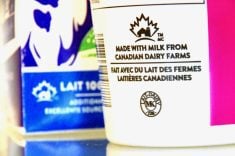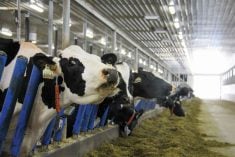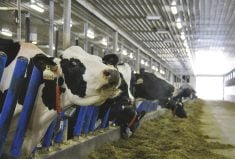A combination of factors, including an increased demand for dairy products, has Manitoba’s dairy farmers shipping 75,000 litres of milk out of province every day.
But changes to the province’s processing capacity have also played a key role, according to Dairy Farmers of Manitoba chairman, David Wiens.
“Probably the biggest reason that that’s been happening over the past year is that the Saputo plant in Winkler was shut down,” he said, adding that while the company is expanding its operation in Brandon, the rebuild has taken longer than anticipated.
“We thought that it would be back to full capacity by November and… it still is not at quite full capacity, so that’s having an effect,” Wiens explained.
Milk first began to flow west following the explosion of a natural gas pipeline near Otterburne in January 2014, which temporarily shut two processing facilities. But as the pipeline was repaired, other changes took hold and the shipments to Saskatoon pro-cessors continued.
Now Saskatoon processors are also at capacity, said Wiens.
Read Also

Cow heat stress cuts at dairy farm profit
Quebec research shows the index for heat and humidity hits threshold more days than expected for dairy cows, resulting in production drops and reproductive issues.
“With production levels in the other provinces, that’s increasingly an issue, because where Saskatoon had the capacity before, that milk is actually being cascaded even farther west and potentially milk will cascade throughout the provinces right through to Abbotsford,” he said.
Shipping milk out of province does create additional costs, but the chairman noted that those costs are shared amongst all producers in the western pool.
“So we’re 17 per cent of the milk pool and so we pay 17 per cent of the cost rather than 100 per cent, so that certainly makes a difference on the part of Manitoba producers’ costs,” Wiens said.
But he added that the growth of small dairy processors has helped ease the crunch. It’s also anticipated Parmalat will build a new facility in Winnipeg, said Wiens. That new facility is expected to be based on a flexible model that allows for expansion.
“There has been an increase in market demand, especially on the industrial milk side, so we’re producing very high volumes of milk,” he said. “And hopefully this will continue.”
Ongoing efforts to promote the quality of Canadian milk, as well as its health benefits, are paying off.
“We will continue to promote our products on the health and wellness, but it’s more than just nutritious and good for you, it’s also lifestyle, so the message has become much broader,” said Wiens. “So all of these things are beginning to have an impact, and we’re certainly up to the challenge of producing the milk for that.”




















